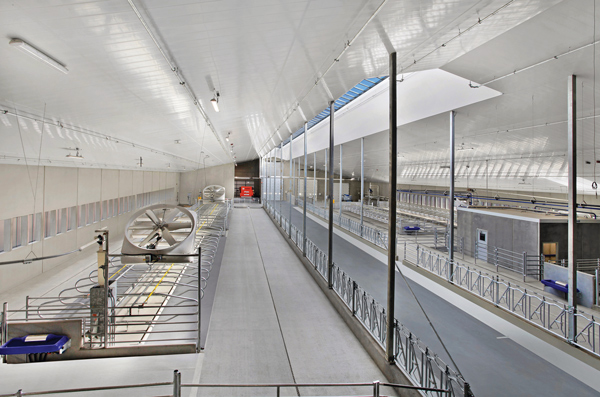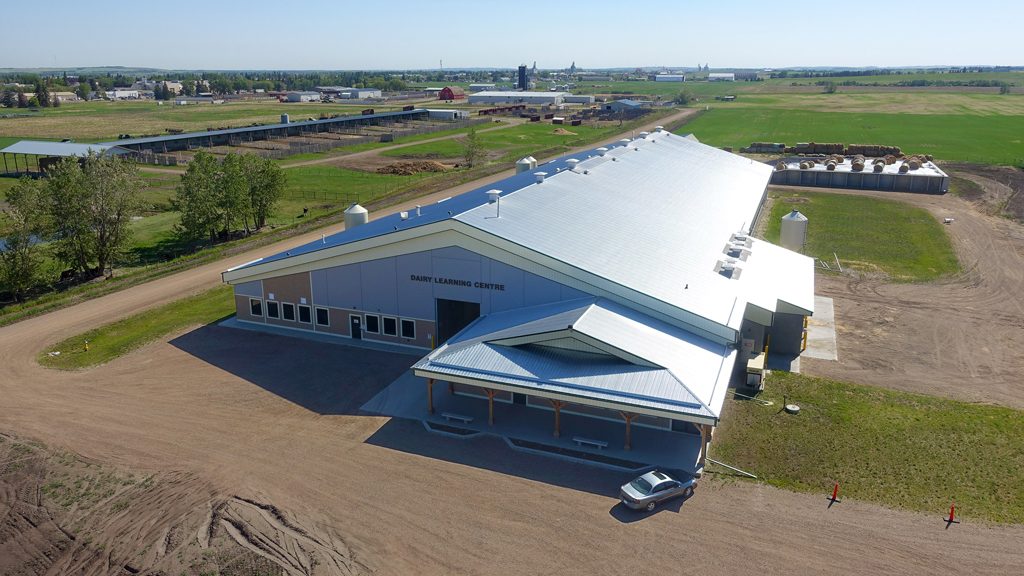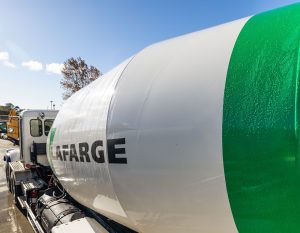Imagine for a minute an upscale senior citizens home where residents are living in the lap of luxury.
The facility uses the very latest labour-saving technology so that its pampered guests rarely see a human caregiver.
That’s the rough equivalent of a large barn in east-central Alberta that 280 lucky dairy cattle call home.
The 46,600-square-foot Dairy Learning Centre at Lakeland College in Vermillion certainly isn’t what most city folks expect a barn to look like.
In addition to the usual silage storage, commodity shed and calf pens, the centre contains such features as robotic milking and feeding systems, automated manure management, herd navigator technology, automatic sort gates and triple foam mattresses.
The centre is also a shining example of agricultural energy efficiency.
The facility features LED lighting with auto dimming; a skylight along the length of the building to reduce lighting loads; an automated side wall curtain and ridge chimney vents for ventilation; and heat exchange plates to lower the temperature of milk from the udder (to reduce the risk of bacterial contamination) and transfer the heat for other purposes.
What helps make this high-tech facility run reliably is that all this fancy equipment is housed inside a precast concrete structure.
“Barns get a lot of rough use,” said Jesse Hawiuk, a spokesman for Eagle Builders, the Blackfalds, Alta. company that made and installed the precast concrete. “With a lot of large animals eating, peeing, defecating and bumping into walls, barns are dirty places, with lots of ammonia gas and high humidity building up.”
A precast concrete barn can last 50 to 100 years, depending on how well it’s maintained, said Hawiuk.
“Every 15 to 20 years, the caulking at the joints in a concrete barn need to be replaced; that’s all,” he said. “A lower cost of maintenance means a lower total cost of ownership.”
Precast concrete is also a flexible construction material with which to build agricultural facilities.

“If a farmer wants to expand his precast barn, it’s easy to add on to the original building,” Hawiuk said.
Precast concrete has important benefits for the construction of agricultural buildings: low maintenance and high durability; corrosion resistance in the high-humidity conditions; and rapid construction.
The building shell of the Dairy Learning Centre was erected in two weeks, the entire centre was completed in five months.
The $9.5-million project, which wrapped up in August 2017, used 2.5 million pounds of precast and 264 precast panels.
The concrete components of the barn are load-bearing structural insulated panels, manufactured with a form liner to simulate a wood grain, for the perimeter walls, and solid interior wall panels, all resting on a cast-in-place concrete slab and a wood-frame roof.
The precast concrete panels are between 5.5 inches and 10 inches thick.
In the same way that buildings for humans are constructed according to design principles, so was the Dairy Learning Centre.
Eagle Builders followed five design principles: safe student and industry training; maximum automation and minimum environmental impact; transition cow management (e.g. a stress-free calving line that reduces the movement between groups of cows); cow comfort and care with automated systems that mean fewer instances of people and equipment disrupting the herd; and bio security which includes a viewing deck plus video feed so people can see milking and herd activity without physically being in the cattle’s space.
The Dairy Learning Centre replaces the previous dairy facility that was built in the 1980s.
The centre is used mainly by students in the dairy major of the animal science technology program.
Founded in 1913, Lakeland is the first agricultural training school in Alberta, said Geoff Brown, associate dean of agricultural sciences.
“University agricultural faculties, which do more research, we focus on practical training and hands-on learning for young people looking for employment in the agricultural industry,” said Brown.
Much has changed in the dairy industry since the college was founded.
“Manual jobs are disappearing,” he said. “The students in the program are learning management and data interpretation skills.”
Between 15 and 20 Lakeland students are managing the dairy barn now, with a bigger enrolment expected in the near future.
“Lakeland has the only two-year dairy training program in Western Canada with a dairy barn,” said Brown. “Our goal is to become a dairy training centre for all of the West.”











Recent Comments
comments for this post are closed